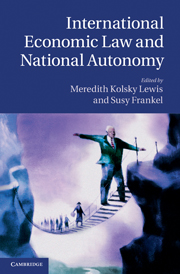Book contents
- Frontmatter
- Contents
- Notes on contributors
- Acknowledgements
- Introduction
- PART I International economic law: conceptions of convergence and divergence
- PART II WTO treaty interpretation: implications and consequences
- 4 Demanding perfection: private food standards and the SPS Agreement
- 5 Eroding national autonomy from the TRIPS Agreement
- 6 The WTO and RTAs: a ‘bottom-up’ interpretation of RTAs' autonomy over WTO law
- 7 ‘Gambling’ with sovereignty: complying with international obligations or upholding national autonomy
- PART III Responding to international economic law commitments
- PART IV Transformations in international economic law
- Index
- References
6 - The WTO and RTAs: a ‘bottom-up’ interpretation of RTAs' autonomy over WTO law
from PART II - WTO treaty interpretation: implications and consequences
Published online by Cambridge University Press: 10 January 2011
- Frontmatter
- Contents
- Notes on contributors
- Acknowledgements
- Introduction
- PART I International economic law: conceptions of convergence and divergence
- PART II WTO treaty interpretation: implications and consequences
- 4 Demanding perfection: private food standards and the SPS Agreement
- 5 Eroding national autonomy from the TRIPS Agreement
- 6 The WTO and RTAs: a ‘bottom-up’ interpretation of RTAs' autonomy over WTO law
- 7 ‘Gambling’ with sovereignty: complying with international obligations or upholding national autonomy
- PART III Responding to international economic law commitments
- PART IV Transformations in international economic law
- Index
- References
Summary
Introduction
The relationship between the WTO and regional trade agreements (RTAs) is usually addressed using a top-down approach that questions the compatibility of the RTAs with the WTO, under the assumption that the larger multilateral legal system perpetually prevails over the regional dealings. Another way of tackling the issue is to treat it as a political phenomenon, which cannot be framed in legal terms.
This chapter suggests a third, bottom-up approach to the question, that RTAs' autonomy over WTO law might be interpreted as tacit performance of an international custom, and not simply as non-compliant behaviours.
The relationship between the WTO and RTAs according to existing doctrine: criticism
A doctrinal approach to the relationship between the WTO legal system and the RTAs usually starts with Article XXIV GATT, Article V GATS and the Enabling Clause, which – it is said – ‘govern’ the formation and further implementation of RTAs, setting down substantial and procedural requirements with which RTAs are obliged to comply.
The intent of the review is to evaluate the degree of consistency of the regional dealings with the multilateral system. Therefore, the extremely complex relationship between WTO law and RTAs is usually tackled in a rather simplified one-way top-down direction.
- Type
- Chapter
- Information
- International Economic Law and National Autonomy , pp. 116 - 140Publisher: Cambridge University PressPrint publication year: 2010
References
- 2
- Cited by



